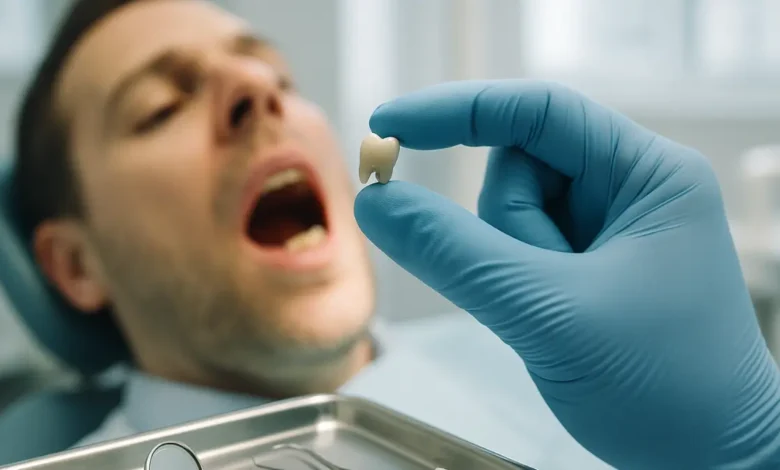Crown Fell Out No Tooth Left: What It Means, What to Do, and How to Fix It Safely

If your crown fell out no tooth left, stay calm. Learn expert-approved next steps, best treatments like implants or bridges, and how to restore your confident smile safely and effectively.
When a dental crown falls out and there’s no tooth left underneath, it can feel like a nightmare moment — a mix of panic, confusion, and discomfort. Whether you’re eating, brushing, or just going about your day, realizing your crown fell out and no tooth is left can raise immediate questions: What now? Can it be fixed? Does it hurt? This article dives deep into understanding what’s happening, why it occurs, and what you can do about it calmly and smartly.
Understanding What a Dental Crown Does
A dental crown is more than just a cap; it’s a protective cover that restores the strength, shape, and function of a damaged tooth. Usually made from porcelain, metal, or ceramic, a crown acts as armor for a tooth that’s been weakened by decay, fracture, or root canal treatment.
But when that tooth beneath becomes too fragile — due to decay, wear, or bone loss — it might no longer be able to hold the crown securely. That’s when you end up in the situation where the crown fell out and no tooth is left to support it anymore.
Dentists refer to this as “loss of tooth structure beneath the crown,” and unfortunately, it’s more common than most people realize.
Why Does a Crown Fall Out When No Tooth is Left?
There are several reasons why your crown fell out and no tooth is left behind:
- Tooth Decay Beneath the Crown:
Even though crowns cover the tooth, decay can still creep in underneath if the seal isn’t perfect. Over time, bacteria eat away at the remaining structure, leaving nothing solid to support the crown. - Fractured Tooth Structure:
The natural tooth can break or crumble if it was already weak, especially under pressure from chewing hard foods or clenching teeth at night. - Old Dental Work:
Crowns have a lifespan, typically 10–15 years. As they age, the materials and adhesives degrade, causing the bond to fail. - Root Canal Treated Teeth:
Teeth that have undergone root canal treatment can become brittle. Without adequate internal support, they might eventually break off under the crown.
When you find that your crown fell out and no tooth is left, it’s a strong signal that the underlying tooth can no longer sustain traditional restoration methods.
Immediate Steps to Take When Your Crown Falls Out
First things first — don’t panic. Losing a crown, even when no tooth remains, isn’t life-threatening. Here’s what to do right away:
1. Save the Crown
Gently rinse the fallen crown with warm water and keep it in a clean container. Even if you think the tooth underneath is gone, your dentist may still want to examine it or reuse the crown temporarily.
2. Inspect the Area
Look inside your mouth using a mirror. If you see only gum tissue and no tooth structure, that’s confirmation that the crown fell out and no tooth is left. You may notice a small stub or sharp edge — avoid touching it too much.
3. Avoid Eating on That Side
Until you get professional help, don’t chew on the side where the crown came out. It can irritate gums or damage surrounding teeth.
4. Call Your Dentist
Explain exactly what happened. Most dentists will schedule you for an urgent visit, especially if there’s pain or exposed nerve tissue.
What Your Dentist Will Do
During your appointment, the dentist will assess whether there’s any tooth structure left. Depending on the situation, there are several treatment paths available.
If Some Root or Tooth Remains
If a tiny amount of root or tooth remains above the gum line, your dentist might perform a post and core buildup. This involves inserting a small metal or fiberglass post into the root canal to act as a foundation for a new crown.
If No Tooth Structure is Left at All
If your crown fell out and no tooth is left, the dentist will likely recommend one of the following:
- Dental Implant:
This is the most permanent solution. The damaged tooth is extracted (if roots remain), and a titanium implant is placed into the jawbone, later topped with a new crown. - Dental Bridge:
If implants aren’t an option, a bridge can replace the missing tooth by anchoring onto adjacent teeth. - Partial Denture:
For those looking for a non-surgical, removable option, a partial denture can fill the gap.
Each choice depends on your bone health, budget, and overall oral condition.
Can You Glue a Crown Back Yourself?
It’s tempting to grab some super glue and fix the issue at home, but that’s a huge mistake. Most adhesives are toxic and not meant for use in the mouth. Even dental-grade temporary cements sold at pharmacies are only short-term fixes.
As professionals often say:
“If your crown fell out and no tooth is left, no glue in the world will bring the tooth back.”
DIY repairs might trap bacteria inside and cause more damage. Always wait for a professional evaluation before attempting reattachment.
What If It Doesn’t Hurt?
Some people feel no pain even when their crown fell out and no tooth is left, which can be misleading. The absence of pain doesn’t mean everything’s fine. The nerves inside the root might have died, or the area might be healing from previous dental work.
Pain often arises later if bacteria reach the exposed tissues or gums become irritated by food particles. So, even if you’re pain-free, you still need to visit your dentist soon.
Possible Complications If Left Untreated
If you decide to “wait it out,” you could be setting yourself up for bigger problems. Common complications include:
- Infection:
Open gum tissue is vulnerable to bacterial invasion. - Shifting Teeth:
Neighboring teeth may drift into the gap, leading to bite misalignment. - Bone Loss:
Without the root or crown, your jawbone can start to deteriorate. - Gum Irritation or Abscess Formation:
Food particles can get trapped, leading to swelling, pus, and pain.
In short, when a crown fell out and no tooth is left, doing nothing can make future dental work harder and more expensive.
Treatment Options Explained
Let’s take a closer look at your choices after diagnosis.
| Treatment Option | Description | Longevity | Cost Range |
|---|---|---|---|
| Dental Implant | Titanium screw inserted into the jawbone to replace the lost tooth | 15–25 years | $$$ |
| Bridge | Uses neighboring teeth as anchors for an artificial tooth | 10–15 years | $$ |
| Partial Denture | Removable replacement that fills the missing gap | 5–10 years | $ |
| Extraction & Bone Graft | Removes root remnants and rebuilds bone for future restoration | Varies | $$ |
“Replacing a missing tooth isn’t just about looks — it’s about keeping your bite, speech, and confidence intact.”
How to Prevent This Problem in the Future
Prevention always beats restoration. Here are some expert tips:
- Regular Dental Checkups:
Get your crowns and teeth checked every six months to catch decay early. - Good Oral Hygiene:
Brush and floss around crowns carefully to prevent bacterial buildup. - Avoid Hard Foods:
Ice, nuts, or hard candies can crack both natural teeth and crowns. - Use a Nightguard:
If you grind your teeth, protect them with a custom nightguard. - Prompt Repairs:
If your crown feels loose, don’t ignore it — early intervention can save the tooth.
Emotional and Confidence Impact
It’s not just about dental health. Losing a crown and realizing no tooth is left can affect your confidence. Smiling, speaking, and eating might feel awkward. This is where modern dentistry shines — advanced cosmetic and restorative treatments can rebuild your smile to look completely natural.
Dentists today use 3D imaging, ceramic blends, and customized shading to make your new crown or implant look just like your original tooth. You won’t just regain your bite — you’ll regain your confidence too.
Expert Opinion: What Dentists Say
“When a crown falls out and there’s no tooth left, it’s not the end of your dental journey — it’s the start of a better one. With implants and modern restorations, patients often end up with stronger and more beautiful results than before.”
— Dr. Melanie Carter, DDS
This perspective reminds us that even though losing a crown is inconvenient, it often leads to long-term improvements in oral health.
FAQs About “Crown Fell Out No Tooth Left”
What should I do if my crown fell out and no tooth is left?
Call your dentist immediately. Do not try to reattach the crown yourself. Keep it safe, and avoid eating on that side until you get professional care.
Can a dentist reattach the crown if no tooth remains?
Usually not. If the tooth structure is completely gone, you’ll need alternative treatments like an implant, bridge, or partial denture.
Is it painful when the crown falls out?
It can be, depending on whether the nerve is exposed. Some people feel sensitivity or soreness, while others feel nothing initially.
Can I eat without the crown?
You can, but it’s best to chew on the opposite side and stick to soft foods until you visit your dentist.
What is the best long-term fix for a lost tooth under a crown?
A dental implant offers the most durable and natural-looking solution. It restores full function and prevents bone loss.
Conclusion
When your crown fell out and no tooth is left, it might feel like a setback — but it’s also an opportunity. Modern dentistry offers several ways to restore your smile permanently and beautifully. The key is not to delay. Seek professional advice, choose the right treatment, and commit to good oral hygiene.
A lost crown doesn’t have to mean a lost smile — it can mark the beginning of a stronger, healthier one.





